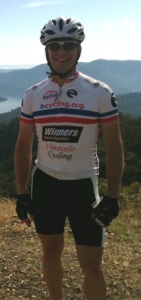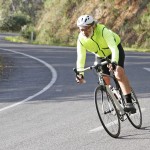While some of us are training for Bicycle Network Victoria’s 3 Peaks Challenge, others are training for various versions of the Audax Alpine Classic on January 29. Anthony Gugel is one such cyclist.
He’s training for the Audax Alpine Classic Extreme (ACE250), an epic 250km journey that covers the same territory as 3 Peaks, and a little bit extra. In this guest post, Anthony documents his last training ride before the ACE250 – a morning spent with the lovely miss Donna Buang.
It’s hard to believe that six months ago I decided to kick off a training plan with the objective of completing the ACE250. The time’s flown by, the training rides have become increasingly difficult and, thankfully, I’ve seen my fitness improve steadily.
The culmination of this training regime was a planned date with the iconic Mt. Donna Buang last Saturday. ‘Donna’ is the closest alpine climb to Melbourne, measuring 16.8km in length and with 1080m of vertical ascent. In Tour de France terms this is rated as a 1st category climb, with only the ‘Hors Category’ (French for f!@#$%g hard!) topping it.
Folklore suggests a Donna climb is a must for anyone riding the Alpine Classic 200km and that a ‘double Donna’ puts you in good stead for the (harder) ACE250. My plan was to do at least the double and if I was feeling good (well, feeling anything below the waist really) I’d attempt a triple Donna.
Longer climbs provide challenges that doing two or three shorter climbs can’t replicate. Like having to pedal non-stop for over an hour and manage your efforts. Like being able to deal with multiple instances of incoherent thoughts as the mental challenge takes its toll. Then there’s the fun (and danger, but don’t tell my wife that) of descending and the technicalities of cornering and braking, and the toll these take on the arms, neck and shoulders.
Sounds easy, right?
On a chilly but gorgeous Saturday morning I drove to Warburton and warmed up for about 15 minutes on the main drag before turning off the highway to commence my maiden Donna climb at around 7am. And it welcomes you with a solid 8% gradient … thanks! Less than 2km into the climb the legs were already grumpy and I was thinking it was going to be a long and painful 17km of climbing.
Realistically I probably needed another 15 minutes of warming up but with some self-management, the beautiful scenery and my favourites tunes playing on the iPhone, I settled into a comfortable rhythm, albeit with the chain firmly implanted on my granny gear.
The first 7km to Cement Creek is known as the harder section of the climb and with good reason. My Garmin didn’t register less than a 6% gradient and the last few kilometres approaching Cement Creek ramp up to 8%, then 10% and even 12% at one point. Luckily, the gradient then eases off at the Creek, providing relief for rapidly fatiguing legs.
‘The best of the best’ do this climb in under an hour but for this mere mortal a time of 1 hour 20 minutes was going to be like winning the Alp d’Huez stage at the Tour de France. A time check at Cement Creek had me, surprisingly, at 30 minutes. Given I was pacing myself for a possible triple ascent I was stoked with this time and decided to give it a little more of a squirt in the second half of the climb.
The gradients are far more respectable from Cement Creek with 5% – 6% sections the norm. However the forecast 40km/h northerlies were now making their presence felt. At about the 11km mark, near the Yarra Valley lookout, the road swings around due north and kicks up to 8%. Combined with the headwind this made for tough going. All I could do was curl myself into as small a parcel as possible and grind away until the road changed course and provided shelter from the wind.

Thankfully it eventually did but this also coincided with the last 2km of the climb, where the gradient ramps up again to 10% to welcome you to the Mt. Donna Buang gate. The last kilometre to the lookout tower had my Garmin reading 11%.
It was a prize worth suffering for though – as I crossed the finish mark on the road and hit the “lap” button, a little under 1 hour 7 minutes came on the display! Woo hoo!
After a very brief pause to devour a jam sandwich and take a massive drink, I donned my wind vest and arm warmers, clipped back in and commenced the awesome descent. Back to Cement Creek the road is smooth and corners flowing, but after this it’s far more technical with lumpy corners ready to catch out the overzealous rider. Twenty minutes later I’d descended the 17km and was ready to do it all over again.
Thankfully my legs were far happier this time around but they did have to contend with a blustery northerly right from the start, making the second climb harder than the first. Despite this and having taken it a little easier I reeled off a respectable 1 hour 12 minutes for the climb and descended like a man possessed. As I grabbed more food and drink from the car I considered my options.
By this time (around 10:30am) the temperature was up near 27ºC and I only had one full bottle of water left. The legs felt OK so I decided to commence a third climb and reassess at Cement Creek. Once again the 8% intro was a rude shock and the legs were barely turning a cadence of 65RPM but I persevered into the by-now stiff northerly.
This is where the mental challenge of sustained climbing efforts came into play and it was a real struggle to manage my efforts near lactate threshold for the 7km to Cement Creek.
But manage it I did and the calming sights and sounds of Cement Creek were once again my reward. At this point, with barely 200ml of water left, I decided the last 9km of climbing was not worth the risk of dehydration, and that 42km and 2,700m of climbing was a fair-enough effort.
And with that, my ACE250 training is done! It’s now time for some modest efforts to maintain fitness and keep my legs fresh until the real test on January 29.
Have you got a climbing-related story you’d like to share? Send Matt an email at theclimbingcyclist@gmail.com with the details.







RT Anthony – spot on! Guys please share your gearing. We’re not all at the same level, but a basic guide you be of help to those you’ve never climbed these mountains before. Back in my race days (i use to ride scratch at A-grade opens) i’d use a 39/19 for most of the climb and a 21 just before Cement Creek. I always use to “spin” a gear, rather than grind it out, unless my base training platform for the week required a “power” session, with a larger gear. most of these climbs require a similar technique – consistancy, meaning if you spin 1 or 2 cogs beneath your maximum, then you’ll avoid lactating and blowing up, and ultimately achieve the same time, as you would if you had tried to go hard at the start with a larger gear. The gear technique is very different to when i use to race up some of these climbs, but for the average rider, using the spin technique is the best way to ride up these longer climbs.
Damian – clearly our definitions of ‘power’ and ‘spin’ are quite different, probably because our capabilities are/were also quite different! I use a 34/24 combination for most of the way to Cement Creek, falling back to 34/26 for the last gasp. 34/22 for most of the rest of the climb. That sees me up the mountain in around 1hr 10mins. I’m guess you were sub 1 hour with your gearing ! Bravo
In response to Anthony on 31/1 I used a 39/27 setup for my Donna climbs.
Great write-up, looking forward to tackling DB for the first time soon (after Lake Mountain). I do wish you would have mentioned your bikes setup, specifically gearing. I started climbing in the area with my racy 11-23 (53/39 front) cassette, but it’s just a bit much, and makes it extremely hard for extended climbing. I’m curious if other “climbers” are using 12-25 or perhaps 12-27/28 cassettes, or even more funky shall I suggest [gasp] a compact crankset or triple? Please share your gearing!
Good read. I also did 2.5 x DB on that lovely morning, probably started first climb about 15 mins ahead of you. But since your first climb was about 8mins quicker than mine, maybe you passed me before the end of the 3rd climb ! I’m ‘only’ doing AAC200 this year, but plan for 3 Peak / ACE250 in the coming years.
Best water source is from the spring in the carpark 3-4 kms from the summit. Super cold, super clean and easy to access, since it has plumbing !Top up your bottles on each descent, and you are good for your next assault.
Great Blog Ant. Good luck on the ACE. I did this climb recently and Once was enough but I then Had to ride back to Emerald.
Triple Donna? I seriously question your mental health!
Awesome post Anthony! Just a tip for anyone climbing Mt. Donna Buang who might run out of water. At that junction where you turn left where it flattens off You can get some water by walking down to the running river (may have 2 jump over fence and take 2 steps 2 reach the actual water). But when u need water u need water 🙂 The water was very clean and tasted beautiful!
Thanks for the positive feedback guys! The training has been based on a solid winter base followed by a steady build up of intensity, time on the bike and climbing. From early November to the 2.5 Donna I rode seven “century plus” rides up to 190km and 3000m of climbing. Tough work but really satisfying!
Great post, this really shows what is necessary to seriously tackle ACE250 (or Three Peaks, for that matter). Must have been a long six months of training!
Great post. I have had the pleasure of riding with Anth and the improvement in his riding through a well considered training plan has been fantastic. All of this done while balancing family and work commitments. I have every confidence he will blitz the ACE250